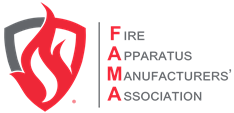In today’s world, technology is evolving at a record pace, and fire apparatus manufacturers are increasingly being requested to incorporate the latest and greatest technological advances in their fire apparatus. When we hear technology, we often think of the latest version of the iPhone, iPad, or something electronic. While those are some of the most recognizable advances in technology, there are other applications, many of which are quite complex. Technological advances in fire apparatus could be the implementation of a seat belt warning system, a vehicle data recorder (VDR), electronic stability control, or air bag system. These may seem to be ordinary technologies of everyday life, however their implementation in fire apparatus can require a great deal of creativity. In the automotive sector, there seems to be significant awareness on autonomous vehicles and continued advancements of crash avoidance systems. Fire Apparatus Manufacturers’ Association (FAMA) member companies add new technology features on a yearly basis, so what’s next for fire apparatus?
Ultra-High-Pressure Foam Systems
The technical committee for National Fire Protection Association (NFPA) 1901, Standard for Automotive Fire Apparatus, recently addressed and developed minimum requirements, for ultra-high-pressure (UHP) foam systems. With a UHP foam system, fire suppression activities are accomplished in an efficient and effective manner.
Global Positioning Systems
Global positioning systems can provide information such as real time location information to dispatch centers and subsequent responding units. This may allow for dispatchers to identify and assign a unit which is geographically closer to the emergency situation, thereby reducing response time and more effectively responding to the situation.
Crash Avoidance Systems
Electronic stability control (ESC) systems are widely used in fire apparatus to mitigate a vehicle crash. They have become a federal motor vehicle safety standard requirement for highway tractors. This system is primarily for crash avoidance.
Automatic emergency braking (AEB) is a technology that is gaining momentum in the passenger car sector of the automotive market. AEB systems help prevent crashes or reduce their severity by applying the brakes for the driver. The systems use vehicle-mounted sensors such as radar, cameras, or lasers to detect an imminent crash, warn the driver, and apply the brakes if the driver does not take action quickly enough.
Autonomous Vehicles or Autonomous Fire Suppression Tools
Many of us have heard the recent buzz around driverless vehicles. While widespread availability of this technology is still a ways off, certain companies are engaged in researching and developing such vehicles. It doesn’t seem practical for a fire apparatus to “drive itself” to an emergency situation. However, it may not be unreasonable to think water or foam streams could be directed at a heat source without operator intervention by using sensors or thermal imaging. It remains to be seen, but the idea may not be as far out as we think.
These are just a few of the ways in which fire apparatus and component manufacturers are using technology to advance the safety and effectiveness of vehicles and first responders. FAMA member companies will continue to work in partnership with the fire service to develop, adapt, and adopt technologies that make sense for the fire industry. Together we can make the high-tech future brighter and safer for all.
FAMA is committed to the manufacture and sale of safe, efficient emergency response vehicles and equipment. FAMA urges fire departments to evaluate the full range of safety features offered by its member companies.
